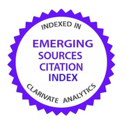Una comparación de la Teoría de Valores Extremos y de los modelos GARCH en términos de medidas de riesgo
DOI:
https://doi.org/10.26360/2018_7Palabras clave:
Teoría de Valores Extremos, modelos GARCH, Índice de Desarrollo Humano, medidas de riesgo, Valor en riesgoResumen
En este trabajo aplicamos Teoría de Valores Extremos (EVT) y modelos de series temporales a ocho mercados bursátiles desarrollados y emergentes, publicados en el índice Morgan Stanley Capital International (MSCI). Basándonos en los rankings del Human Development Index (HDI), que son consistentes con el índice MSCI, analizamos Singapur, España, Reino Unido y Estados Unidos para los mercados bursátiles desarrollados, y Chile, Rusia, Malasia y Turquía para los mercados bursátiles emergentes. Utilizamos los precios diarios (en dólares USD) de estos ocho países para el período desde enero de 2014 a diciembre de 2017, y examinamos el funcionamiento de los modelos basados en el testeo en muestras. Calculando el valor en riesgo (VaR) como medida de riesgo para las colas derecha e izquierda del retorno en logaritmos de los modelos seleccionados, comparamos estos países en términos de sus riesgos financieros. Las medidas de riesgo obtenidas nos permiten debatir la agrupación y el ranking de los mercados bursátiles y sus posiciones relativas.
Descargas
Citas
Aas, K. and X. K. Dimakos (2004). Statistical modelling of financial time series: An introduction. Technical report, Norwegian Computing Center, Applied Research and Development. Project no: 220194.
Ahoniemi, K. (2008). Modeling and forecasting the VIX index. SSRN, 1–22.
Bugge, S. A., Guttormsen, H. J., Molnár, P., and Ringdal, M. (2016). Implied volatility index for the Norwegian equity market. International Review of Financial Analysis 47; 133–141.
Camilleri, S. J. (2006). An analysis of stock index distributions of selected emerging markets. Bank of Valletta Review 33, 33-49.
Davidson, W. N., Kim, J. K., Ors, E., and A. Szakmary (2001). Using implied volatility on options to measure the relation between asset returns and variability. Journal of Banking & Finance, 25(7); 1245–1269.
Ekşi, Z., Yıldırım, İ., and K. Yıldırak (2006). Alternative risk measures and extreme value theory in finance: Implementation on ISE 100 index. International Conference on Business, Economics and Management, İzmir, Turkey, Yaşar University.
Gençay, R. and F. Selçuk (2004). Extreme value theory and value-at-risk: Relative performance in emerging markets. International Journal of Forecasting 20(2): 287–303.
Gençay, R., Selçuk, F., and A. Ulugülyağcı (2003). High volatility, thick tails and extreme value theory. Insurance: Mathematics and Economics 33(1): 337–356.
Gilli, M. and E. Këllezi (2000). Extreme value theory for tail-related risk measures. International Center for Financial Asset Management and Engineering FAME Research Paper Series rp18.
Hamilton, J. D. (1994). Time Series Analysis. Princeton University Press.
Jorion, P. (2001). Value at Risk. McGraw-Hill.
Lawler, C. C. (2003). A time-series analysis of the Shanghai and New York stock price indices. Annals of Economics and Finance, 4(1):17–35.
Ma, L. (2013). Mutual fund flows and performance: A survey of empirical findings. Technical report, Working Paper.
McNeil, A. J. (1997). Estimating the tails of loss severity distributions using extreme value theory. Astin Bulletin 27(1): 117–137.
MSCI (2018). MSCI Indexes: End of day data (Country). https://www.msci.com/end-of-day-data-country. Accessed: 2018-07-02.
Rizvi, S. A. A., Roberts, S. J., Osborne, M. A., and F. Nyikosa (2017). A novel approach to forecasting financial volatility with gaussian process envelopes. Technical report, Machine Learning Research Group, Oxford-Man Institute of Quantitative Finance, University of Oxford.
Rocco, M. (2014). Extreme value theory for finance: A survey. Journal of Economic Surveys, 28(1). 82-108
Simon, D. P. (2003). The nasdaq volatility index during and after the bubble. The Journal of Derivatives, 11(2):9–24.
UNDP (2014). United Nations Development Programme: Human development reports, human development data 2014. http://hdr.undp.org/en/data. Accessed: 2018-07-02.
Villasenor-Alva, J. A. and E. Gonzalez-Estrada (2009). A bootstrap goodness of fit test for the generalized Pareto distribution. Computational Statistics and Data Analysis 53(11): 3835–3841.
Descargas
Publicado
Cómo citar
Número
Sección
Licencia
Derechos de autor 2023 Ezgi Nevruz, Şule Şahin

Esta obra está bajo una licencia internacional Creative Commons Atribución-NoComercial-SinDerivadas 4.0.
















